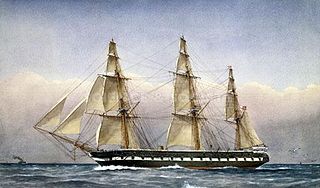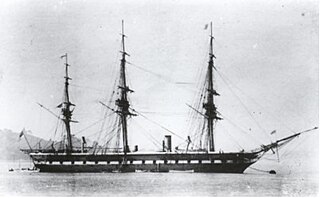
An ironclad is a steam-propelled warship protected by iron or steel armor plates, constructed from 1859 to the early 1890s. The ironclad was developed as a result of the vulnerability of wooden warships to explosive or incendiary shells. The first ironclad battleship, Gloire, was launched by the French Navy in November 1859 – narrowly pre-empting the British Royal Navy.

The first USS Wampanoag was a screw frigate in the United States Navy built during the American Civil War.

The French ironclad Gloire was the first ocean-going ironclad, launched in 1859. She was developed after the Crimean War, in response to new developments of naval gun technology, especially the Paixhans guns and rifled guns, which used explosive shells with increased destructive power against wooden ships. Her design was also influenced by the Anglo-French development of ironclad floating batteries to bombard Russian forts during the same war.

USS Merrimack, also improperly Merrimac, was a steam frigate, best known as the hull upon which the ironclad warship CSS Virginia was constructed during the American Civil War. The CSS Virginia then took part in the Battle of Hampton Roads in the first engagement between ironclad warships.

USS Katahdin, a harbor-defense ram of innovative design, was the second ship of the United States Navy to be named for Mount Katahdin, a mountain peak in Maine.

Jylland is one of the world's largest wooden warships, and is both a screw-propelled steam frigate and a sailship. It took part in the Battle of Heligoland on 9 May 1864, and is preserved as a museum ship in the small town of Ebeltoft, located on the Djursland peninsula in Denmark.

HMS Prince of Wales was one of six 121-gun screw-propelled first-rate three-decker line-of-battle ships of the Royal Navy. She was launched on 25 January 1860.

USS Contoocook was a screw sloop-of-war built for the United States Navy during the American Civil War. She is named after a river and village in New Hampshire. She was launched 3 December 1864 at Portsmouth Navy Yard and commissioned 14 March 1868, commanded by Captain George Balch.
Callao was a Samar-class gunboat of the Spanish Navy which served in the Spanish fleet from 1888 to 1898 and fought in the Spanish–American War.

Jorge Juan was a Jorge Juan-class sloop of the Spanish Navy which was sunk off Cuba during the Spanish–American War.

HMS Glasgow was a wooden screw frigate, the fifth ship of the name to serve in the Royal Navy.
USS Wanaloset, also spelled USS Wanalosett, was a proposed United States Navy screw sloop-of-war or steam frigate that appears never to have been laid down.
USS Arapahoe was a proposed United States Navy screw sloop-of-war or steam frigate that was cancelled in 1866 without being completed.
USS Keosauqua was a proposed United States Navy screw sloop-of-war or steam frigate that was cancelled in 1866 without being completed.
USS Willamette was a proposed United States Navy screw sloop-of-war or steam frigate that was cancelled in 1866 without ever having been laid down.

The Pervenets-class ironclads were a group of three armored frigates built for the Imperial Russian Navy in the 1860s. The first ship was built in England because the Russian Empire lacked the ability to build its own ironclads, but the other two were built in Russia. All three ships differed from one another as the design evolved over time. None of the ships ever saw combat and only Kreml had an eventful career, sinking a wooden frigate in an collision in 1869 and sinking herself in 1885. She was refloated and returned to service. They were assigned to the Baltic Fleet upon completion and never left Russian waters. They served with the Gunnery Training Detachment for the bulk of their careers before being reduced to reserve in 1904. They were sold four years later and Pervenets and Ne Tron Menia were converted into coal barges. Pervenets survived World War II and was scrapped in the early 1960s, Ne Tron Menia was sunk during the war and scrapped around 1950, while Kreml's fate after her sale is unknown

HMS Newcastle was a wooden screw frigate, the fifth ship of the name to serve in the Royal Navy.

HMS Undaunted was a wooden screw frigate, the fifth ship of the name to serve in the Royal Navy.

The Ister-class frigates were a group of five 36-gun screw frigates ordered for the Royal Navy in the early 1860s. Four of the ships were cancelled after they were laid down and HMS Endymion was the only ship completed.

John Lenthall was an important American shipbuilder and naval architect. He was responsible for the construction and repair of United States Navy ships during the American Civil War (1861–1865), as well as in the years immediately before and after it. His career spanned the U.S. Navy's transition from sail to steam propulsion and from wooden ships to ironclads, and in retirement he participated in early planning for an eventual steel navy.














